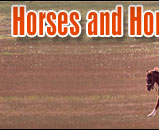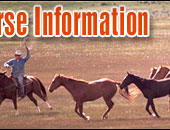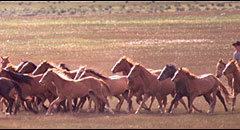 |
   |
|
|
|
You are here: Horses > Horse health > Equine Acupuncture |
Acupuncture Treatments for Your Horse and Other Animals
Acupuncture has slowly been gaining in popularity with horse
owners and veterinarians since its introduction in the
1970s. It is a standard treatment worldwide today for
helping athletes, both human and equine; maintain top
physical condition and performance. But the practice is not
without controversy. |
|
|
Acupuncture treatments consist of the careful placement of
sterile needles at certain points on the body. These points
are determined by the body’s flow of energy, which was
discovered by the ancient Tibetans and Chinese. They called
it Qi, which is pronounced “chee.” While these ancient
healers did not understand energy as electricity, and did
not know that most bodily functions are indeed caused by
small negative or positive charges, their concept of energy
flow is a good one. When |
the current is
allowed to flow normally, the body works well. However,
blockages in the current cause problems such as pain,
weakness, loss of muscle tone, or tumors.
According to the Chinese, every organ has its own function
and its own corresponding Qi. These functions might sound a
little odd to Westerners. One example is the spleen, which
in the Chinese tradition is thought to digest food and keep
everything in its proper place. For example, it keeps the
blood flowing in the veins, the saliva in the mouth, etc.
Today, veterinarians can tell you that the spleen’s function
is to regulate the blood and lymph, but few know that it is
also what prevents uterine prolapse in a foaling mare.
When acupuncture points are stimulated, the body releases
different chemicals according to the placement of the
needles. If, for example, acupuncture is performed on an
anxious horse, endorphins can be released that will help it
to relax. Another example is a horse that is not running
properly due to shoulder pain. Correctly placed acupuncture
needles can help to release the blocked energy, as well as
releasing painkilling hormones such as enkephlins and
metenkephlins in the central nervous system. These hormones
not only ease the horse’s pain, they also promote healing of
the joint by reducing swelling and inflammation.
Before an examination by an acupuncturist, he or she might
wish to speak with your regular veterinarian or may perform
a regular Western examination himself. This gives both you
and the acupuncturist the most complete information
available about the horse’s condition. Then the
acupuncturist will ask you to describe the horse’s symptoms,
its normal daily routine—such as the amount of time spent in
the stall or pasture—the horse’s social standing in the
herd, and whether the horse seems to prefer heat or cold.
Then he or she may look at the tongue, take the horse’s
pulse in several locations over the body, and examine the
meridians. These are the channels through which the Qi is
said to flow.
No one is positive that horses have meridians, although it
is accepted that humans do. However, research indicates that
horses do indeed have these channels for Qi. These meridians
make it possible for a tender area to receive treatment
without the acupuncturist actually having to put needles
into the injured or sore area.
Examining the meridians involves finding the areas which are
tender and evaluate how these areas relate to the horse’s
injury or ailment. This information, combined with the
veterinary or Western evaluation and the interview with the
owner, allows the acupuncturist to make a diagnosis and
begin treatment.
While improvement is generally seen after each treatment,
but owners should be aware that acupuncture is not an
instant fix. Multiple sessions are usually needed before the
ailment or injury is healed. Also, because acupuncture
treatments address the flow of Qi in the entire animal, many
times owners will see that other problems in the horse are
relieved in addition to the specific ailment the
acupuncturist is treating.
There are several techniques common in acupuncture, and some
or all may be used by your acupuncturist depending on the
horse’s condition.
“Dry needling” is the most basic of acupuncture techniques.
Slender needles are inserted into acupuncture points, and
nothing is injected.
Electroacupuncture involves the use of a mild to moderate
electrical current once the needles are inserted. A machine
is used to send the current through small wires connected to
the acupuncture needles. This is most commonly used when
stimulation of deep acupuncture points is desired.
If the horse has a Qi deficiency, heat at the acupuncture
points is indicated. This can speed the healing process. An
herbal preparation from the mugwart plant called moxibustion
is commonly used for this purpose.
Sometimes the acupuncturist will inject something into the
acupuncture points, such as saline, vitamins, or
antibiotics. This is known as aquapuncture, and produces
stimulation of the points for several days after the
treatment. It is sometimes used in place of dry needling,
and it can be a very effective treatment.
If even more prolonged stimulation of the points is desired,
the acupuncturist might recommend gold bead implantation. By
surgically implanting gold beads, wire, or threads at the
acupuncture points, animals with chronic or progressive
diseases can receive the maximum health benefits of
acupuncture. It can even reduce the need for daily use of
medicines.
 |
Read the next horse health tips article on Horse Massage. |
|
|
|
|
 |
|
|
 |
 |




Over 20 years of experience selling quality horse saddles & show tack.
Huge selection of different saddle types & brands.
Family owned & operated.
Free shipping on all saddles.
Horse Saddle Shop doesn't sell any saddles, owners Dale and Chuck wouldn't buy themselves!
Visit the Horse Saddle Shop today and receive top notch advice on purchasing a horse saddle that fit your riding needs.
|
|
|
 |
|
|
|
Horse Education
|
|
|
|
|
Horse Information Topics
|
|
|
|
|
|
|
|
Horse Business Owners
|
| |
Advertise with Us
Have your horse products or services exposed to over 27,000 of our monthly visitors.
|
|
|
|
|
|